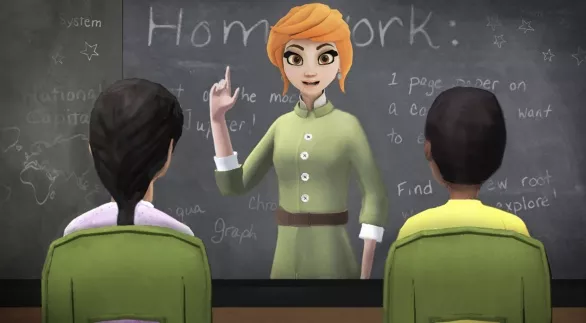When you are working with a Learner who is at a very early stage of understanding how to participate in a conversation, the Floreo lessons Join a Conversation: Park and Join a Conversation: Cafeteria are a good place to start. The lesson objectives are fairly basic: a) listen to an ongoing conversation and determine the topic; then b) offer an on-topic comment. These lessons have potential pauses built into the pace of the conversation so that you can walk an individual step-by-step through the interaction and then speed up the pace as the Learner gains proficiency. Additionally, the conversations can be repeated with faded prompting to help someone learn how to accomplish these tasks independently. Here's how:
For Learners who are just starting their conversational journey,
- Let the Learner know what the topic of conversation is at the beginning of the lesson;
- Pause after each comment and help the Learner find the keywords in the character's comment that relate to the topic. (For thoughts on how to help someone understand keywords, check out this blog post.);
- When you get to the point where it is the Learner's turn to talk, it might be helpful to point out that all the characters are looking at the Learner. This clues Learners into recognizing body language and helps them to know that it is their turn to talk;
- A Learner at this level will likely need help formulating a comment that will go with the conversation. A prompting question such as: "Tell the kids what your favorite ___ (movie, pizza topping, etc.,) is." or explore what the Learner interests are in the topic and prompt: "Tell the students: I really like to ___ (draw/paint, watch basketball, etc.)"
Once Learners begin to learn how to find the keywords in the sentence and identify the topic, replay the lesson. This time,
- Don't tell the individual in advance what the topic of conversation is.
- At this level, determine whether the Learner still needs you to pause between the lines of dialogue uttered by the characters. If they don't, you can increase the pace of the character's dialogue.
- You may want to confirm that they know the topic. At some point, you may want to simply ask whether or not they know the topic and then confirm that they know the topic by assessing whether they can offer an on-topic comment.
- If the Learner asks an on-topic question, be sure to reinforce that as an appropriate conversational turn. Then, redirect them toward an on-topic comment.
Some of the Learners we work with do their best to provide an on-topic comment, but unless you are very familiar with the Learner, you might not understand the connection between the comment they make and the topic at hand. For example, the topic may be movies, but the Learner says, "I like spiders." As someone familiar with this individual, you may know that the scenes in the movie Spider-Man that show actual spiders are a favorite. In this case, the Learner is trying to stay on topic but doesn't have the expressive language skills to fully convey the connection. This is where targeted conversational repair comes in. You can still use the off-topic button on the Coach's dashboard, but instead of using the suggested banner language, help the Learner refine the comment to fill in the gaps. You could say: These students are confused because they don't have enough information. Try saying: "The spider scenes in Spider-Man are my favorite."
An individual who has "graduated" from this lesson, should be able to go through the lesson with minimal verbal input from the Coach. When launching the lesson, ask them to listen, then trigger each comment in real time and refrain from asking them to confirm the topic. When it is the Learner's turn to talk, you may need to ask: "What would you like to say about this?", but ideally, they would notice that all the characters are looking expectantly at the Learner. At that point, the Learner should be able to provide an on-topic comment.
Proficiency with conversations involves many skills, including active listening, turn-taking, generating comments and questions, and using and understanding body language. Opportunities to learn and improve those skills can be found in a variety of lessons, including Choose Your Greeting, Small Talk in Motion, Chit-Chat with Alejandro, Find a Seat in the Classroom, Teen Talk: Social Squares 2, and more.





-1.png?width=550&height=250&name=Untitled%20(3)-1.png)